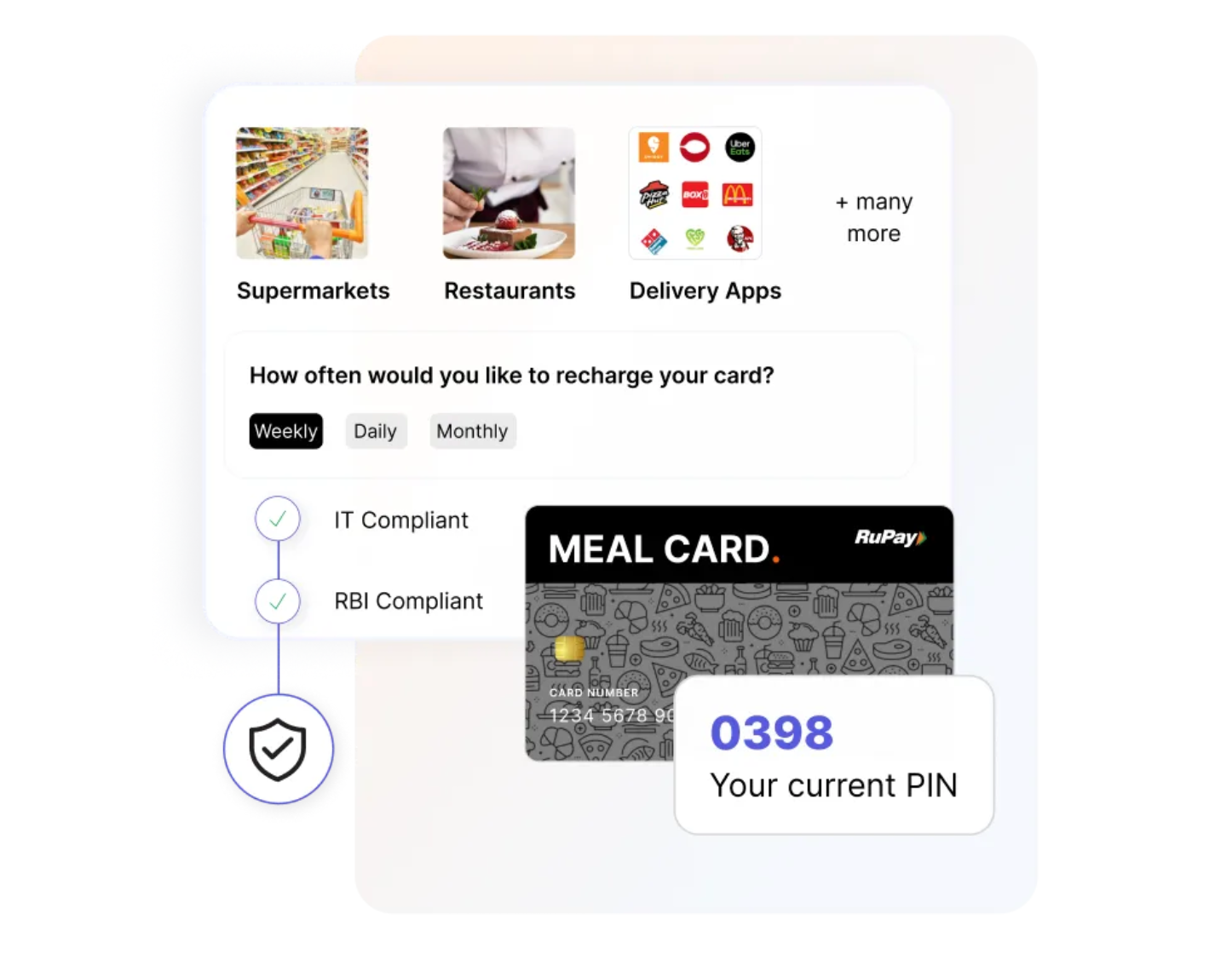Nourrir la productivité : Comment introduire une indemnité de repas pour les employés
Découvrez les étapes clés de l'introduction d'une indemnité de repas pour les employés et alimentez la productivité sur le lieu de travail. Améliorez la satisfaction et le bien-être des employés grâce aux indemnités de repas.
Sur cette page
- Qu'est-ce que l'indemnité de repas pour les employés ?
- Importance de fournir des indemnités de repas aux employés
- How does meal cards work in terms of meal allowance?
- Types d'indemnités de repas pour les salariés
- Considérations juridiques et réglementations relatives aux programmes d'indemnités de repas pour les employés
- Concevoir une politique efficace en matière d'indemnités de repas
- Comment les entreprises peuvent-elles maximiser la valeur des indemnités de repas ?
- Empuls: A convenient solution for pricing meal allowances for employees
- 4 Entreprises ayant mis en place des programmes d'indemnités de repas avec succès
- Conclusion
- FAQs
Dans l'environnement de travail actuel, qui évolue rapidement, les organisations s'efforcent de créer une atmosphère dans laquelle les employés se sentent valorisés et soutenus. L'un des moyens d'y parvenir est d'offrir une indemnité de repas aux employés.
Les indemnités de repas sont des avantages financiers accordés par l'employeur pour couvrir le coût des repas pris dans le cadre d'activités professionnelles. Elles peuvent prendre la forme d'indemnités fixes, de remboursements de frais réels ou d'indemnités journalières.
L'objectif des indemnités de repas est de veiller à ce que les employés aient accès à des repas nutritifs lorsqu'ils sont engagés dans des activités professionnelles, qu'il s'agisse de se déplacer pour le travail, d'assister à des conférences ou à des réunions, ou d'effectuer des heures supplémentaires. Les employeurs répondent aux besoins fondamentaux de leurs salariés en leur offrant des indemnités de repas et en favorisant leur bien-être et leur satisfaction.
Qu'est-ce que l'indemnité de repas pour les employés ?
Une indemnité de repas pour les salariés désigne une somme d'argent spécifique allouée par un employeur pour couvrir le coût des repas pendant les heures de travail. Il s'agit d'un avantage accordé aux employés pour leur permettre d'avoir accès à des repas sur le lieu de travail.
L'indemnité de repas peut prendre la forme d'une allocation en espèces, d'un remboursement des frais de repas ou d'une carte de repas prépayée que les employés peuvent utiliser dans les restaurants affiliés ou les cafétérias du site.
Meal cards, also known as food or lunch cards, are prepaid cards or vouchers issued to employees by their employers to cover the cost of meals. These cards function as digital payment, allowing employees to conveniently purchase meals at affiliated restaurants, cafes, or canteens.
L'indemnité de repas répond aux besoins nutritionnels des salariés, améliore leur bien-être et favorise un environnement de travail positif. Elle peut également servir à se conformer aux exigences légales ou aux conventions collectives concernant les dispositions relatives aux repas des employés.
Importance de fournir des indemnités de repas aux employés
L'octroi d'indemnités de repas témoigne de l'engagement de l'employeur en faveur du bien-être et de la satisfaction de son personnel. Avec l'aide d'une allocation repas sous forme de cartes repas, les employeurs s'assurent que les employés ont accès à des repas nutritifs et abordables pendant leurs heures de travail. Cela contribue à leur bien-être physique et améliore leur satisfaction au travail et leur productivité.
En outre, les indemnités de repas peuvent constituer un avantage précieux pour attirer et retenir les meilleurs talents. Sur un marché de l'emploi concurrentiel, les entreprises qui offrent des avantages sociaux complets, y compris des indemnités de repas, ont plus de chances de se démarquer et d'attirer des professionnels qualifiés. Cela montre que l'employeur accorde de l'importance aux besoins et au confort de ses employés, ce qui favorise l'engagement et la loyauté de ces derniers.
Voici d'autres raisons de mettre en place des indemnités de repas dans les entreprises :
- Le bien-être des employés : L'octroi d'indemnités de repas témoigne de la volonté de répondre aux besoins nutritionnels des salariés, de promouvoir leur santé et de veiller à ce qu'ils aient l'énergie nécessaire pour accomplir leurs tâches efficacement.
- Commodité : Les indemnités de repas simplifient le processus de gestion des frais de repas par les employés, en leur évitant de dépenser leurs fonds et de soumettre des notes de frais individuelles.
- Contrôle des coûts : La fixation d'un montant fixe pour l'indemnité de repas ou l'utilisation de tarifs journaliers peut aider les employeurs à établir des coûts prévisibles pour le remboursement des repas, ce qui rend la budgétisation et la planification financière plus faciles à gérer.
- Conformité : Dans certains cas, l'octroi d'indemnités de repas peut être une obligation légale ou une disposition d'une convention collective, ce qui permet aux employeurs de s'acquitter de leurs obligations.
How does meal cards work in terms of meal allowance?
Les cartes repas fonctionnent sur la base d'un système de paiement numérique. Lorsqu'ils reçoivent la carte repas, les employés peuvent la charger d'une somme d'argent prédéterminée, qui peut varier en fonction des politiques de l'entreprise ou des postes occupés par les employés. Les cartes sont généralement rechargeables, ce qui permet aux employés d'ajouter des fonds en fonction de leurs besoins.
Les employés qui souhaitent acheter un repas peuvent présenter leur carte-repas aux restaurants ou aux prestataires de services alimentaires affiliés. La carte est glissée ou scannée, et le montant correspondant est déduit du solde de la carte. Certaines cartes repas peuvent également comporter un code PIN pour plus de sécurité lors des transactions.
Types d'indemnités de repas pour les salariés
Voici les trois types d'indemnités de repas pour les salariés :
1. Indemnité de repas fixe
Une indemnité forfaitaire de repas est une somme d'argent prédéterminée versée aux employés pour les repas pris dans le cadre de leurs activités professionnelles. Ce type d'indemnité offre un montant de remboursement cohérent et prévisible, indépendamment des dépenses réelles encourues par le salarié.
Les employeurs fixent généralement l'indemnité fixe en fonction de facteurs tels que le coût moyen des repas dans la région où l'employé travaille ou les exigences spécifiques de la fonction. Bien qu'une indemnité de repas fixe simplifie le processus de remboursement pour les employés, les employeurs doivent veiller à ce que le montant de l'indemnité corresponde au coût raisonnable des repas dans le contexte donné.
2. Remboursement des frais réels
Le remboursement des frais réels implique que les salariés présentent des reçus ou des notes de frais afin d'être remboursés du montant exact qu'ils ont dépensé pour leurs repas. Cette méthode exige des salariés qu'ils gardent une trace de leurs frais de repas et qu'ils fournissent des pièces justificatives à l'employeur.
Avec le remboursement des frais réels, les employés sont remboursés sur la base des coûts réels qu'ils ont encourus, ce qui garantit qu'ils ne sont pas sur ou sous-compensés. Toutefois, cette approche peut être administrativement lourde pour les employés et les employeurs, car elle implique une tenue méticuleuse des dossiers, un traitement en temps voulu et une vérification des dépenses.
3. Indemnité journalière
Les indemnités journalières représentent un montant forfaitaire destiné à couvrir les repas et les frais accessoires pendant les activités liées au travail. L'employeur détermine le taux de l'indemnité journalière, qui est généralement basé sur des facteurs tels que le lieu et la durée de l'activité professionnelle.
Les indemnités journalières simplifient le remboursement en évitant aux salariés de devoir présenter des reçus ou des notes de frais. Au lieu de cela, les salariés reçoivent un montant journalier prédéterminé destiné à couvrir les repas et autres frais accessoires, tels que les pourboires ou les petits achats. Les employeurs se réfèrent souvent aux taux d'indemnités journalières établis par les autorités fiscales ou les normes sectorielles pour garantir l'équité et la conformité.
Employers must carefully evaluate these factors and consider the needs and preferences of their employees when designing their meal allowance policy
Considérations juridiques et réglementations relatives aux programmes d'indemnités de repas pour les employés
Voici les considérations juridiques et les réglementations relatives à l'introduction de programmes d'indemnités de repas pour les employés.
1. Aperçu des dispositions légales relatives aux indemnités de repas
Pour garantir la conformité, les employeurs doivent se familiariser avec les lois et règlements applicables en matière d'indemnités de repas. Les exigences légales spécifiques peuvent varier en fonction de la juridiction, du secteur et des contrats de travail. Il est essentiel de consulter des professionnels du droit ou des experts en droit du travail pour comprendre les obligations et les restrictions spécifiques qui s'appliquent dans le contexte de votre organisation.
Les considérations juridiques les plus courantes sont les suivantes :
- Réglementation fiscale: Les autorités fiscales ont souvent des règles spécifiques concernant le traitement fiscal des indemnités de repas. Les employeurs et les employés doivent connaître les implications fiscales, par exemple si les indemnités sont soumises à l'impôt sur le revenu, à l'impôt sur les salaires ou aux cotisations de sécurité sociale.
- Le droit du travail et les contrats de travail: Les conventions collectives ou les contrats de travail peuvent contenir des dispositions relatives aux indemnités de repas. Les employeurs doivent veiller au respect de ces accords et de toutes les exigences minimales fixées par le droit du travail, telles que l'octroi de pauses repas ou de montants de remboursement minimaux.
- Justificatifs des dépenses: En fonction de la juridiction et de la méthode de remboursement choisie, les employeurs peuvent demander aux employés de fournir des documents justificatifs, tels que des reçus ou des notes de frais, pour justifier leurs frais de repas.
2. Discussion des implications fiscales pour les employeurs et les employés
- Implications fiscales pour l'employeur: Les indemnités de repas versées aux employés peuvent avoir des conséquences fiscales pour l'employeur, y compris des déductions ou des exonérations fiscales potentielles. Les employeurs doivent consulter des professionnels de la fiscalité ou des comptables pour comprendre le traitement fiscal spécifique des indemnités de repas dans leur juridiction.
- Implications fiscales pour les employés: Les salariés peuvent être tenus d'inclure les indemnités de repas dans leur revenu imposable, en fonction de la législation fiscale applicable. Toutefois, certains types d'indemnités ou de méthodes de remboursement peuvent faire l'objet d'exceptions ou d'exclusions. Les employés doivent consulter des conseillers fiscaux ou se référer aux directives fiscales pour déterminer leurs obligations fiscales.
3. Respect du droit du travail et de la réglementation en matière d'emploi
Les employeurs doivent s'assurer que leur politique en matière d'indemnités de repas est conforme à la législation et à la réglementation du travail afin d'éviter d'éventuels problèmes juridiques. Il s'agit notamment de se conformer aux exigences relatives aux pauses repas, aux heures de travail maximales et aux montants minimaux de remboursement. Il est essentiel de se tenir au courant des modifications apportées à la législation du travail et d'examiner et de réviser périodiquement la politique en matière d'indemnités de repas afin de garantir une conformité permanente.
Concevoir une politique efficace en matière d'indemnités de repas
Voici quelques facteurs importants à prendre en compte lors de l'élaboration d'une politique efficace en matière d'indemnités de repas :
1. Facteurs à prendre en compte pour déterminer le montant de l'indemnité
- Coût de la vie: Tenez compte du coût moyen des repas dans les régions où les employés mènent des activités liées à leur travail. Tenez compte des différences de prix régionales et ajustez le montant de l'allocation en conséquence afin de vous assurer qu'elle couvre des frais de repas raisonnables.
- Normes sectorielles: Recherchez des références ou des lignes directrices spécifiques au secteur pour les indemnités de repas afin d'obtenir des informations sur les pratiques standard et de garantir la compétitivité sur le marché.
- Rôles et responsabilités professionnels: Les exigences en matière de repas peuvent varier d'une fonction à l'autre, en fonction de la fréquence des déplacements, de l'accueil des clients ou du travail en dehors des heures normales de bureau. Adaptez le montant de l'allocation aux exigences spécifiques de chaque fonction.
- Durée des activités liées au travail: Tenez compte du fait que les employés seront engagés dans des missions de courte durée ou des voyages d'affaires prolongés. Ajustez le montant de l'allocation pour tenir compte des besoins variables en matière de repas en fonction de la durée de l'activité.
2. Fixer les critères d'éligibilité des salariés
- Voyages et activités professionnelles: Déterminez quels employés auront droit à des indemnités de repas en fonction de leur participation à des déplacements professionnels, à des réunions avec des clients ou à d'autres activités professionnelles nécessitant des repas.
- Postes ou niveaux d'emploi: Déterminez si les indemnités de repas s'appliqueront à des postes spécifiques ou si elles seront accessibles à tous les employés de l'organisation. Cela peut dépendre de l'ancienneté, des responsabilités professionnelles ou de la nécessité de s'aligner sur les conventions collectives.
- Affectations temporaires ou permanentes: Définissez si les indemnités de repas seront accordées pour des emplois rapides ou si elles s'appliqueront aux employés de manière permanente. Communiquez les critères d'éligibilité afin de garantir la cohérence et l'équité.
3. Définir le champ d'application et les limites de l'indemnité
- Types et occasions de repas: Précisez les repas qui peuvent faire l'objet d'un remboursement. Il peut s'agir du petit-déjeuner, du déjeuner, du dîner ou des collations prises pendant les activités professionnelles. Déterminez si l'indemnité couvre les repas avec les clients, les repas d'équipe ou les repas pendant les déplacements.
- Exclusions et restrictions: Communiquez toute limitation des frais de repas que l'allocation ne couvrira pas, comme les boissons alcoolisées ou les options de restauration extravagantes. Définissez des limites de dépenses raisonnables afin de garantir une utilisation responsable de l'allocation.
- Fréquence des remboursements: Déterminez la fréquence à laquelle les employés peuvent prétendre à des indemnités de repas (quotidienne, hebdomadaire ou mensuelle), en fonction de la nature de leurs activités professionnelles. Établissez des lignes directrices et des délais clairs pour la présentation des demandes de remboursement.
4. Développer un processus de remboursement équitable et transparent
- Exigences en matière de documentation: Précisez les documents que les employés doivent fournir pour justifier leurs frais de repas, tels que les reçus ou les notes de frais. Communiquez la procédure de soumission et de vérification des dépenses.
- Délais de remboursement: Définissez le délai dans lequel les remboursements seront effectués. Fixez des délais raisonnables pour que les employés soient remboursés rapidement de leurs frais de repas.
- Communication et formation: Communiquer efficacement la politique d'indemnité de repas aux employés, en veillant à ce qu'ils comprennent les critères d'éligibilité, le processus de remboursement et les limites. Fournir une formation ou des ressources pour aider les employés à documenter et à soumettre avec précision les frais de repas.
Comment les entreprises peuvent-elles maximiser la valeur des indemnités de repas ?
Les entreprises peuvent maximiser la valeur des indemnités de repas en mettant en œuvre les stratégies suivantes :
1. Encourager les choix alimentaires sains
- Fournir une éducation nutritionnelle et des ressources pour aider les employés à faire des choix alimentaires éclairés.
- Proposer des repas sains et variés à la cafétéria ou donner accès à des services de livraison de repas sains.
- Organiser des ateliers ou des séminaires sur la nutrition et le bien-être afin de promouvoir des habitudes alimentaires saines parmi les employés.
2. Personnaliser les indemnités de repas
- Comprendre les préférences et les restrictions alimentaires des employés afin de s'assurer que leurs repas répondent à leurs besoins individuels.
- Offrir une certaine souplesse dans l'utilisation de l'indemnité de repas, en permettant par exemple aux employés de choisir leurs fournisseurs préférés ou des services de livraison de repas.
- Proposer des options aux employés ayant des besoins alimentaires particuliers, comme des repas végétariens, végétaliens ou sans gluten.
3. Solliciter le retour d'information et les suggestions des employés
- Solliciter régulièrement l'avis des employés sur leur programme d'indemnités de repas.
- Réaliser des enquêtes ou des groupes de discussion pour recueillir des informations sur l'efficacité et le degré de satisfaction du programme.
- Utiliser les commentaires des employés pour apporter les ajustements et les améliorations nécessaires au programme, en veillant à ce qu'il corresponde à leurs besoins et à leurs préférences.
4. Favoriser une expérience gastronomique positive
- Créez des espaces de restauration accueillants et confortables sur le lieu de travail, encourageant les employés à prendre leurs repas ensemble et à nouer des relations.
- Envisagez d'incorporer des événements gastronomiques à thème ou des friandises spéciales occasionnelles pour rendre l'expérience gastronomique agréable et mémorable.
5. Assurer une administration sans faille
- Simplifier le processus d'accès et de gestion des indemnités de repas, en utilisant des plateformes ou des applications numériques pour le suivi et le remboursement.
- Rationaliser les procédures administratives, en minimisant la paperasserie et en réduisant la charge de travail des employés lorsqu'ils soumettent des demandes de remboursement.
Empuls: A convenient solution for pricing meal allowances for employees

Adoptez les cartes repas de Empuls pour offrir aux employés un moyen flexible d'utiliser leur indemnité de repas. La carte repas offre une liberté de choix puisqu'elle peut être utilisée dans des magasins en ligne et hors ligne.
- Économies d'impôts: Offrir des avantages fiscaux aux employés et aux employeurs
- Validité: Valable pour un an et renouvelable annuellement
- Pratique: Facilité de gestion de l'allocation alimentaire par les RH
- Flexibilité: Flexibilité pour l'achat de différents types d'aliments
- Conformité: 100% conforme aux réglementations IT et RBI
- Rechargeable: Fréquence de rechargement selon la politique de l'entreprise
- Sécurité: Délivrés avec un code PIN unique, ils sont sécurisés.
4 Entreprises ayant mis en place des programmes d'indemnités de repas avec succès
Voici deux exemples d'entreprises ayant mis en place avec succès des programmes d'indemnités de repas :
1. Google
Google est connu pour ses politiques et avantages centrés sur les employés, notamment un programme d'indemnités de repas qui connaît un grand succès. L'entreprise offre à ses employés des repas et des en-cas gratuits dans des cafétérias et des micro-cuisines sur place. Ces établissements proposent diverses options alimentaires, y compris des menus sains et variés, répondant aux différentes préférences et exigences diététiques.
Le programme d'indemnités de repas de Google garantit que les employés ont accès à des repas nutritifs et pratiques et favorise un sentiment de communauté en encourageant les employés à dîner ensemble et à collaborer dans un environnement détendu.
2. Salesforce
Salesforce, une société mondiale d'informatique dématérialisée, dispose d'un programme d'indemnités de repas très apprécié appelé "The Ohana Café". L'entreprise offre à ses employés une généreuse indemnité journalière de repas au café du site. Le Ohana Café offre une variété d'options alimentaires saines et d'origine locale, répondant à différents besoins alimentaires et favorisant le bien-être.
Le programme comprend également une initiative "Food for Thought", dans le cadre de laquelle les employés peuvent participer à des cours de cuisine et à des ateliers sur la nutrition et les compétences culinaires. Le programme d'indemnités de repas de Salesforce contribue non seulement au bien-être des employés, mais favorise également la camaraderie et l'équilibre entre vie professionnelle et vie privée.
3. Airbnb
Airbnb, la célèbre place de marché en ligne pour l'hébergement et les expériences, a mis en place un programme d'allocation repas appelé "Lunchtime Well-being" (bien-être à l'heure du déjeuner). L'entreprise verse à ses employés une indemnité journalière pour le déjeuner, qu'ils peuvent utiliser dans des restaurants proches ou par l'intermédiaire de services de livraison de repas.
Ce programme encourage les employés à faire une pause au travail, à découvrir la cuisine locale et à interagir socialement à l'heure du déjeuner. En proposant diverses options de restauration, le programme d'indemnités de repas d'Airbnb contribue au bien-être et à la commodité des employés et favorise un meilleur équilibre entre vie professionnelle et vie privée.
4. Asana
Asana, une plateforme de gestion du travail de premier plan, dispose d'un programme d'indemnités de repas très apprécié appelé"Asana Eats". L'entreprise fournit à ses employés une allocation mensuelle spécifiquement destinée aux repas. Cette allocation peut être utilisée dans des restaurants, des cafés et des services de livraison de nourriture partenaires.
Le programme d'Asana encourage les employés à explorer les restaurants locaux, à essayer de nouvelles cuisines et à soutenir les petites entreprises de leurs communautés. Le programme d'indemnités de repas favorise non seulement la satisfaction et la commodité des employés, mais contribue également à favoriser une culture d'entreprise dynamique et inclusive.
Conclusion
Les indemnités de repas pour les employés sont un avantage précieux qui peut améliorer la satisfaction des employés, la productivité et l'équilibre entre vie professionnelle et vie privée. En concevant et en mettant en œuvre avec soin une politique d'indemnités de repas, les organisations peuvent démontrer leur engagement en faveur du bien-être des salariés et créer un environnement de travail favorable.
FAQs
1. How much is the meal allowance?
The meal allowance, often referred to as the per diem rate for meals and incidental expenses (M&IE), varies depending on the location of travel. These rates are established annually by the U.S. General Services Administration (GSA) for locations within the continental United States. For specific rates applicable to your travel destination, you can refer to the GSA's per diem rates.
2. What is the standard meal allowance method?
The standard meal allowance method allows taxpayers to deduct a set per diem rate for meals and incidental expenses instead of tracking and deducting actual costs. This simplifies record-keeping, as you only need to document the time, place, and business purpose of your travel without retaining individual meal receipts.
3. Who gets a 100% meal deduction?
Under typical circumstances, most business meal expenses are subject to a 50% deduction. However, certain situations qualify for a 100% deduction, including:
- Meals provided for the convenience of the employer: For example, meals provided on the employer's premises to more than half of the employees to keep them working late or on weekends.
- Company-wide events: Such as holiday parties or annual picnics primarily for the benefit of employees who are not highly compensated.
4. What is the maximum tax-free meal allowance?
The maximum tax-free meal allowance corresponds to the federal per diem rate for meals and incidental expenses for a given location. Employers can reimburse employees up to this rate without the amount being considered taxable income. Reimbursements exceeding the federal per diem rate may be subject to taxation.













